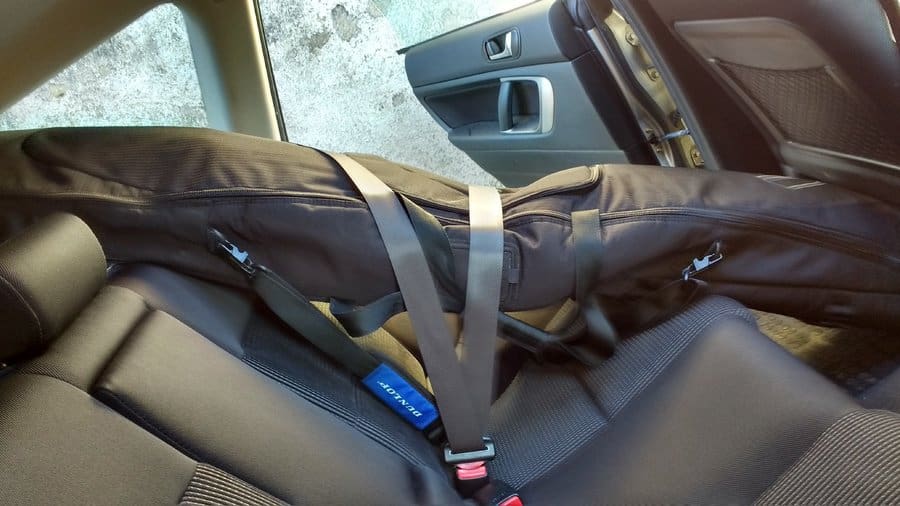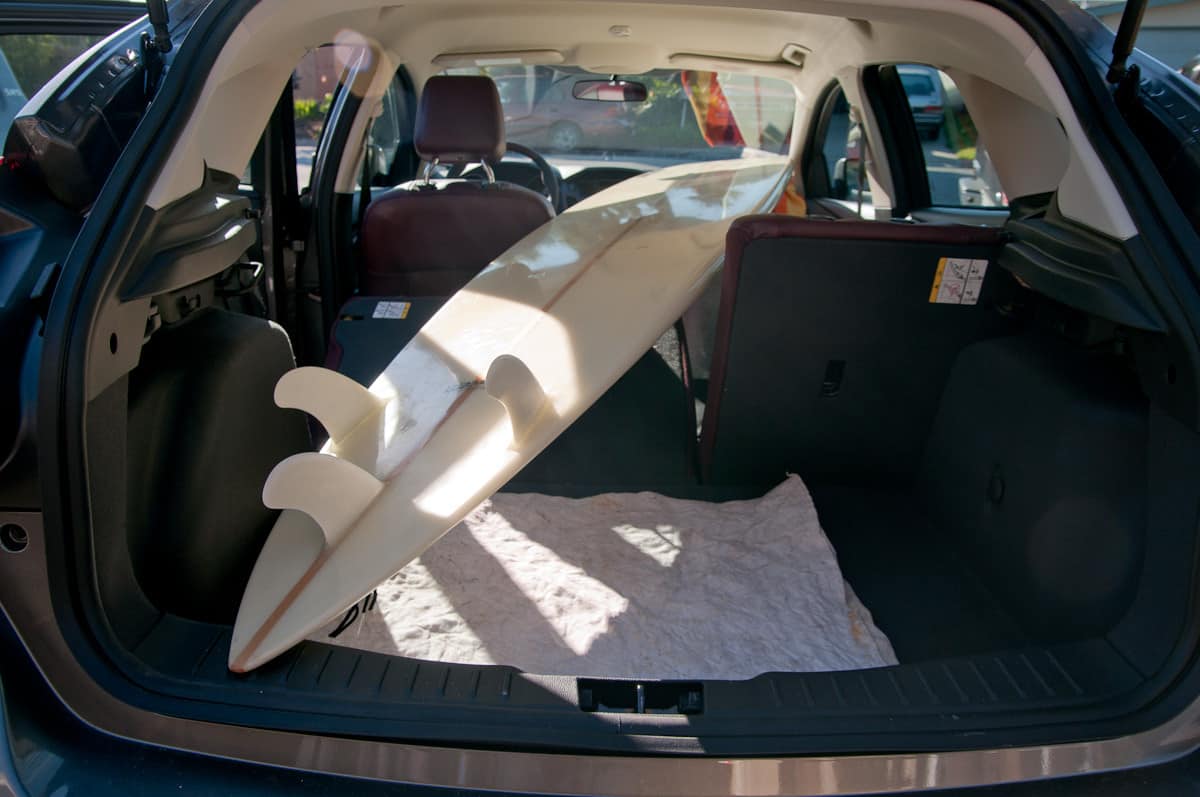Heat is the enemy of surfboards. Surfboard experts will tell you that no matter which materials or compounds a surfboard is made from, at higher temperatures surfboards will become damaged, either requiring repair, or replacement.
Is it bad to leave your surfboard in the car? Yes it is bad to leave a surfboard in the car because the car interior is like a greenhouse with temperatures getting hotter the longer you leave your surfboard there. The temperature inside a car, after 30 minutes on an 80-degree day, climbs up to 115 degrees. The surfboard’s enemy is heat more than it is sunlight.
How Hot Does It Get In A Car?
The part of the car we sit in and drive, and where we keep things, is mostly windows. The windshield and the rear window extend the full width of the car, and the side windows are large as well. Car windows are large, so the driver can see in front, behind and peripherally. Road conditions constantly change, and we also need to know what other drivers are doing relative to where we are driving.
Windows let in heat from sunlight, and it’s a lot more than most of us know. When we park the car at home or in a parking lot when we go shopping, we make sure all the windows are rolled up and we lock the doors. When we leave the car in the sun, the interior accumulates heat rapidly. We’ve all heard about pets dying, even small children, who’ve been left in cars inside sealed windows after only 15 minutes.
When the temperature outside rises to 70 degrees, within 10 minutes, it’s 89 degrees inside a car. When it’s 75 degrees, the interior temperature goes up to 94 degrees in 10 minutes, After 30 minutes, the interior soars to 109 degrees.
Within 10 minutes on a day when it’s 85 degrees outside, a car’s interior temperature after 10 minutes is 104 degrees; after a half-hour, it’s a steamy 119 degrees.
On a very hot day, such as when the heat outside is 95 degrees, it becomes 115 degrees inside a car after 10 minutes. 30 minutes after the car sits in this heat, it’s 130 degrees in the car’s interior. Real damage begins to occur to surfboards at these temperatures, so you should never leave your surfboard in the car.
What Happens To A Surfboard When It’s Exposed To Heat?
Many surfers are surprised when they go to grab their boards and find the board has “blown up” from gases having been released after the board was exposed to heat for too long. Surfboards are made from synthetic chemicals and the molecular structure of these chemicals alters when heated up. This is why it’s important to keep your surfboard cool at all times when you’re not using it.
Surfboards contain polyurethane, found in the foam on the deck of the surfboard. To make the elegant shape of a surfboard, manufacturers use toluene diisocyanate and other materials. These TDI foams are almost exclusive to manufacturing surfboards.
These foam products, when exposed to heat, like the quickly building heat levels inside a car, will “explode,” causing bumps on the board or raised bubbles on the surface.
Epoxy is used in making surfboards too. EPS foam is inexpensive and lightweight, making it a perfect material for the surfboard’s core. Board makers make sheets of EPS that are cut and designed for the surfboard’s shape.
When epoxy boards heat up, it releases an incredible amount of gas. The gas is forced out by the heat, creating bubbles on the board’s surface. Sometimes it’s a collection of tiny bubbles on the deck, but often the gases will blow out bubbles so large that the board can’t be used to paddle or stand on.
The epoxy resin begins to break down at temperatures nearing 130 degrees. It becomes brittle and lowers the life expectancy of surfboards. Play it safe and keep your board out of the car, and don’t leave it in any other hot space.
Where Are The Best Ways To Care For My Surfboard?
Even in the heat of summer, a garage is a great place to store your board. The air is cooler and less humid.
Store your surfboard perpendicular to the ground. If you lean it against the wall, it will warp over time. You can also store it horizontally, but it must be parallel to the floor. Don’t store your surfboard at an angle.
Remove old wax from your surfboard before applying new wax. Stripping away old wax is one of the easiest things to do. Put the surfboard out in the sun for about 15 to 30 minutes. The sunlight will begin to melt the wax off. Take the surfboard away from the sun and lay it flat. Take a credit card or some similar straightedge tool and pull away the built-up wax.
Leaving old wax on a surfboard will make it lose its color, making it grayer and duller. When the old wax is stripped away. Apply fresh new wax to the board.
Repair dents on the board as soon as they occur as possible. Check your board each time after you surf. Buy a surf repair kit. These contain paste and an applicator to patch up your board by filling in cracks and popping out dents. Neglecting patching small cracks will eventually break down the board. Surfing challenging waves such as point breaks, where rocks are nearby is more challenging to your surfboard. Boards that are not taken care of properly can crack in half on rougher rides.
Invest in a surfboard bag. Most of the damage that happens to surfboards happens when you’re not surfing. You’ll get a few dings here and there, maybe a crack you need to patch up. But the real dangers happen at home, or on the way home.
Things at home can fall on the surfboard, tools, and bicycles in the garage that falls on it, or people accidentally bumping into it while trying to get around it and causing it to fall. These things happen all the time and are blameless mistakes.
You can take control and make sure it doesn’t happen by buying a surfboard bag. Bags won’t prevent every ding that happens, but it will keep it safer.
But the best reason to have a surfboard bag is to keep it stored away from the sunlight. You can add years to the life of your surfboard just by zipping it into with a cloth or hard shell surfboard bag. Hard shell bags are more expensive (upwards of $100.00), but unless you’re a traveling surfer or on the pro circuit, you can get away with a simple, well-made cloth bag that can run you $30.00 or a little more.

What’s The Best Way To Transport The Surfboard By Car?
Transporting a surfboard is more dangerous to the board than you might think. Follow these tips and you’ll enjoy your board much longer.
- Always transport using a surfboard bag. Even little bangs occur as you put the board through the trunk over folded down seats. We tend to hit the top of the trunk, and worse, we slide it against the trunk top, scraping the board. Friction of this kind scrapes off the top layers of the deck, exposing the epoxy underneath and weakening the board.
- Put a seat belt on your surfboard. This will prevent it from moving around and banging into the sides of the car. Bumping the board against hard surfaces causes damage that you may not see at first.
- Invest in high-quality tie-downs when strapping to the roof of a car. You don’t want the board to move at all on the roof. It bangs against the rails when it’s loose and surfboards don’t like being hit.
- Don’t load your board into the car through the sides or the car’s sunroof. I can’t remember a time when I tried that without banging up the surfboard.
When you get to the beach, hold the surfboard under your arm like you would college textbooks. Don’t ever drag a surfboard in the sand or along the ground!
Related Questions
How Should I Fasten A Surfboard To The Roof Of The Car?
Fasten them tightly to the roof using straps, preferably locking straps. Then tie a knot around the roof carrier and lead the excess strap through the car window to further ensure the board doesn’t while you drive is especially important when your route to the beach is in highway traffic at high speed or when you make fast turns.
Are There Surfboards That I Can Leave In My Car?
Foam top surfboards don’t need to be waxed, and they are more resistant to the sunlight. Note the word “more” resistant. This means that at some point they will break down as well. Remember it’s the heat that breaks down the surfboard’s molecular structure, so any board that has polyurethane and epoxy in its components will eventually start to break down.
Rule of thumb: never leave any surfboard in the heat or the sunlight.
What Other Kinds Of Damage Is Caused By Heat?
There are several other problems caused by excessive heat. Use common sense. Wax will melt in the heat and after a time the limited layer covering the board will start to melt in a process called delamination. Just don’t do it. Ever.

